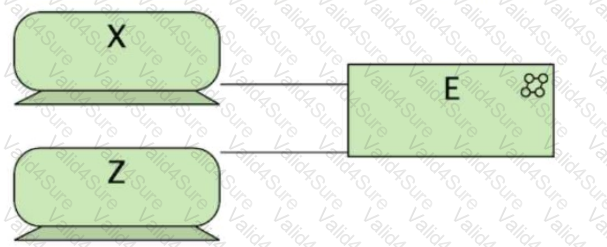Comprehensive and Detailed In-Depth Explanation:
Theblack diamond notationinArchiMaterepresents aComposition relationship, which is used to indicatewhole-part relationshipsbetween elements.
Financial Processingis thewhole(parent element).
X, Y, and Zaresub-functions, meaning they arepart ofFinancial Processing.
Compositionisa strong relationship, meaning thesub-functions (X, Y, and Z) do not exist independently outside Financial Processing.
Analysis of Answer Choices:
✅A. The financial processing function is composed of three sub-functions X, Y, and Z.→✅Correct Answer
Composition relationshipsin ArchiMate indicate that one element ispart of anotherin a strict, whole-part hierarchy.
ArchiMate 3.2 Specification, Section 6.4.2, definesComposition as a structural relationship where the child elements belong strictly to the parent.
SinceFinancial Processing contains X, Y, and Z as integral sub-functions, this is the correct choice.
✅B. The financial processing function aggregates the three sub-functions X, Y, and Z.→âŒIncorrect
Aggregationis aweakerrelationship in ArchiMate compared toComposition.
In Aggregation,the sub-functions can exist independently, whereas in Composition, theycannot.
ArchiMate 3.2 Specification, Section 6.4.1, states thatAggregation does not enforce a strict whole-part relationshiplike Composition does.
✅C. The financial processing function is influenced by the three sub-functions X, Y, and Z.→âŒIncorrect
Influence relationshipsin ArchiMatedo not represent whole-part structures.
Influence is amotivation relationship, meaning it represents animpact or effect, not astructural dependency.
✅D. The financial processing function is assigned the three sub-functions X, Y, and Z.→âŒIncorrect
Assignment relationshipsare used to indicate thata behavior element (e.g., function, process) is performed by an active structure element (e.g., role, actor, component).
This diagramdoes not depict an assignment relationship; instead, itshows a structural composition.
Final Answer:✅A. The financial processing function is composed of three sub-functions X, Y, and Z.
References:
ArchiMate 3.2 Specification: Sections 6.4.2 (Composition), 6.4.1 (Aggregation), and 6.5 (Influence & Assignment).
Archi User Guide: Modeling business functions and composition relationships.






